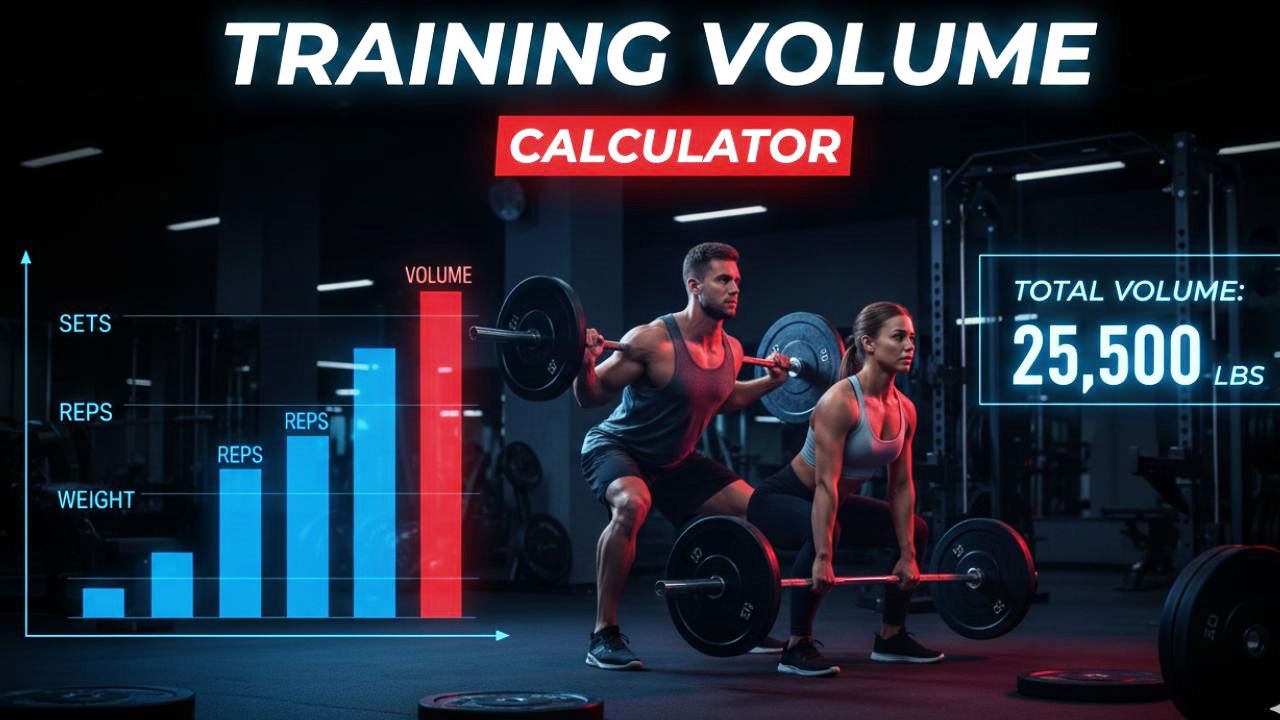Training Volume Calculator
Calculate your workout volume and get personalized training recommendations

What Is Training Volume?
Training volume measures the total amount of work you do in a workout. It helps you understand your training load and track progress over time. Simply put, it’s how much weight you move during your session.
By calculating volume, you can make sure you’re challenging your muscles enough to grow stronger without overdoing it and risking injury.
Understanding Training Volume & Hard Sets
Training volume measures total work done, but hard sets (RPE 6+) are what drive real progress. Our calculator tracks both traditional volume and the modern “hard sets” metric for more accurate training guidance.
If you do 4 sets of 10 reps with 135 lbs at RPE 8 (hard):
Volume = 4 × 10 × 135 = 5,400 lbs
Hard Sets = 4 sets (all RPE 8+)
The volume shows total work, but hard sets show training quality.
Hard Sets Recommendations by Training Goal
Research shows that hard sets (RPE 6+) are the key driver of progress. Here’s how many you should aim for per muscle group per week:
How to Use This Calculator
- Enter your exercise name (optional but helpful for tracking)
- Select the primary muscle group being trained
- Input the number of sets you performed
- Enter reps per set
- Rate how hard each set felt (RPE) – this determines if it’s a “hard set”
- Add the weight used (choose lbs or kg)
- Click “Add Exercise” if you want to include more movements
- Calculate to see your volume, hard sets, and personalized recommendations
Why Training Volume Matters
Training volume helps you understand if you’re doing enough work to see results. Here’s why getting it right matters:
- Track Quality Work: Hard sets (RPE 6+) are what drive real progress, not just total volume
- Monitor Muscle Balance: See which muscle groups you’re training and ensure balanced development
- Prevent Overtraining: Track hard sets per muscle group to avoid excessive stress on any one area
- Optimize Recovery: Higher hard set counts require more recovery time between sessions
⚕️ Important Safety Notes
Training volume is a helpful tool, but always prioritize proper form over lifting heavier weights. Start with moderate volumes and gradually increase as your body adapts. If you feel excessive soreness or fatigue, reduce your volume and allow more recovery time. Consult with a qualified trainer if you’re new to strength training or have any health concerns.
References
- Ralston GW, Kilgore L, Wyatt FB, Baker JS. The Effect of Weekly Set Volume on Strength Gain: A Meta-Analysis. Sports Med. 2017 Dec;47(12):2585-2601.
- Nunes JP, Kassiano W, Costa BDV, Mayhew JL, Ribeiro AS, Cyrino ES. Equating Resistance-Training Volume Between Programs Focused on Muscle Hypertrophy. Sports Med. 2021 Jun;51(6):1171-1178.
- Da Silveira, T. B., De Almeida, G. P., Junior, N. C., Machado, A. F., Rica, R. L., Pontes, F. L., Scartoni, F. R., Bullo, V., Gobbo, S., Bergamin, M., Bocalini, D. S., Figueira Júnior, A., & João, G. A. (2025). Quantification of weekly strength-training volume per muscle group in competitive physique athletes. Frontiers in Sports and Active Living, 7, 1536360.
- Clemente, F. M., Moran, J., Zmijewski, P., Silva, R. M., & Randers, M. B. (2025). Impact of Lower-Volume Training on Physical Fitness Adaptations in Team Sports Players: A Systematic Review and Meta-analysis. Sports Medicine – Open, 11(1), 1-36.
